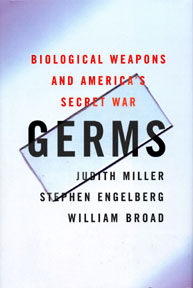Related Research Articles

Biological warfare, also known as germ warfare, is the use of biological toxins or infectious agents such as bacteria, viruses, insects, and fungi with the intent to kill, harm or incapacitate humans, animals or plants as an act of war. Biological weapons are living organisms or replicating entities. Entomological (insect) warfare is a subtype of biological warfare.

Bioterrorism is terrorism involving the intentional release or dissemination of biological agents. These agents include bacteria, viruses, insects, fungi, and/or toxins, and may be in a naturally occurring or a human-modified form, in much the same way as in biological warfare. Further, modern agribusiness is vulnerable to anti-agricultural attacks by terrorists, and such attacks can seriously damage economy as well as consumer confidence. The latter destructive activity is called agrobioterrorism and is a subtype of agro-terrorism.

Iraq actively researched and later employed weapons of mass destruction (WMD) from 1962 to 1991, when it destroyed its chemical weapons stockpile and halted its biological and nuclear weapon programs as required by the United Nations Security Council. The fifth president of Iraq, Saddam Hussein, was internationally condemned for his use of chemical weapons during the 1980s campaign against Iranian and Kurdish civilians during and after the Iran–Iraq War. In the 1980s, Saddam pursued an extensive biological weapons program and a nuclear weapons program, though no nuclear bomb was built. After the Gulf War (1990–1991), the United Nations located and destroyed large quantities of Iraqi chemical weapons and related equipment and materials; Iraq ceased its chemical, biological and nuclear programs.

David Christopher Kelly was a Welsh scientist and authority on biological warfare (BW). A former head of the Defence Microbiology Division working at Porton Down, Kelly was part of a joint US-UK team that inspected civilian biotechnology facilities in Russia in the early 1990s and concluded they were running a covert and illegal BW programme. He was appointed to the United Nations Special Commission (UNSCOM) in 1991 as one of its chief weapons inspectors in Iraq and led ten of the organisation's missions between May 1991 and December 1998. He also worked with UNSCOM's successor, the United Nations Monitoring, Verification and Inspection Commission (UNMOVIC) and led several of their missions into Iraq. During his time with UNMOVIC he was key in uncovering the anthrax production programme at the Salman Pak facility, and a BW programme run at Al Hakum.

Judith Miller is an American journalist and commentator known for her coverage of Iraq's Weapons of Mass Destruction (WMD) program both before and after the 2003 invasion, which was later discovered to have been based on inaccurate information from the intelligence community. She worked in The New York Times' Washington bureau before joining Fox News in 2008.
Steven Jay Hatfill is an American physician, pathologist and biological weapons expert. He became the subject of extensive media coverage beginning in mid-2002, when he was a suspect in the 2001 anthrax attacks. His home was repeatedly raided by the FBI, his phone was tapped, and he was extensively surveilled for more than two years; he was also terminated from his job at Science Applications International Corporation (SAIC). At a news conference in August 2002, Hatfill denied that he had anything to do with the anthrax letters and said "irresponsible news media coverage based on government leaks" had "destroyed his reputation". He filed a lawsuit in 2003, accusing the FBI agents and Justice Department officials who led the criminal investigation of leaking information about him to the press in violation of the Privacy Act.

Kanatzhan "Kanat" Alibekov, known as Kenneth "Ken" Alibek since 1992, is a Kazakh-American microbiologist, bioweaponeer, and biological warfare administrative management expert.
Anthrax hoaxes involving the use of white powder or labels to falsely suggest the use of anthrax are frequently reported in the United States and globally. Hoaxes have increased following the 2001 anthrax attacks, after which no genuine anthrax attacks have occurred. The FBI and U.S. postal inspectors have responded to thousands of "white powder events" and targets have included government offices, US embassies, banks and news organizations.

Mobile weapons laboratories are bioreactors and other processing equipment to manufacture and process biological weapons that can be moved from location to location either by train or vehicle. Allegations that Iraq had access to such equipment were made by the United States in the lead-up to the Iraq War. Subsequent investigations failed to find any evidence of Iraq having access to a mobile weapons lab.
Agroterrorism, also known as agriterrorism and agricultural terrorism, is a malicious attempt to disrupt or destroy the agricultural industry and/or food supply system of a population through "the malicious use of plant or animal pathogens to cause devastating disease in the agricultural sectors". It is closely related to the concepts of biological warfare, chemical warfare and entomological warfare, except carried out by non-state parties.
The Anthrax Vaccine Immunization Program (AVIP), is the name of the policy set forth by the U.S. federal government to immunize its military and certain civilian personnel with BioThrax, an anthrax vaccine manufactured by Emergent BioSolutions Inc. It was set up by the Clinton administration.
Jeanne Harley Guillemin was an American medical anthropologist and author, who for 25 years taught at Boston College as a Professor of Sociology and for over ten years was a senior fellow in the Security Studies Program at Massachusetts Institute of Technology. She was an authority on biological weapons and published four books on the topic.
The United States biological weapons program officially began in spring 1943 on orders from U.S. President Franklin Roosevelt. Research continued following World War II as the U.S. built up a large stockpile of biological agents and weapons. Over the course of its 27-year history, the program weaponized and stockpiled the following seven bio-agents :
Project Bacchus was a covert investigation by the Defense Threat Reduction Agency US Defense Department to determine whether it is possible to construct a bioweapons production facility with off-the-shelf equipment.

In 1984, 751 people suffered food poisoning in The Dalles, Oregon, United States, due to the deliberate contamination of salad bars at ten local restaurants with Salmonella. A group of prominent followers of Rajneesh led by Ma Anand Sheela had hoped to incapacitate the voting population of the city so that their own candidates would win the 1984 Wasco County elections. The incident was the first and is still the single largest bioterrorist attack in U.S. history.
The 2001 anthrax attacks, also known as Amerithrax, occurred in the United States over the course of several weeks beginning on September 18, 2001, one week after the September 11 terrorist attacks. Letters containing anthrax spores were mailed to several news media offices and to Senators Tom Daschle and Patrick Leahy, killing five people and infecting 17 others. According to the FBI, the ensuing investigation became "one of the largest and most complex in the history of law enforcement".

Saddam Hussein (1937–2006) began an extensive biological weapons (BW) program in Iraq in the early 1980s, despite having signed the Biological Weapons Convention (BWC) of 1972. Details of the BW program and a chemical weapons program surfaced after the Gulf War (1990–91) during the disarmament of Iraq under the United Nations Special Commission (UNSCOM). By the end of the war, program scientists had investigated the BW potential of five bacterial strains, one fungal strain, five types of virus, and four toxins. Of these, three—anthrax, botulinum and aflatoxin—had proceeded to weaponization for deployment. Because of the UN disarmament program that followed the war, more is known today about the once-secret bioweapons program in Iraq than that of any other nation.
Project Jefferson was a covert U.S. Defense Intelligence Agency program designed to determine if the current anthrax vaccine was effective against genetically modified bacteria. The program's legal status under the 1972 Biological Weapons Convention (BWC) is disputed.

Germs: Biological Weapons and America's Secret War is a 2001 book written by New York Times journalists Judith Miller, Stephen Engelberg, and William Broad. It describes how humanity has dealt with biological weapons, and the dangers of bioterrorism. It was the 2001 New York Times #1 Non-Fiction Bestseller the weeks of October 28 and November 4.
Before the 20th century, the use of biological agents took three major forms:
References
- ^ Journalists offered Iraq war medals by Richard Norton-Taylor. February 24, 2004, in The Guardian.
- ^ The weekend warriors go to war by Audrey Gillan. October 14, 2004, in The Guardian .
- ^ Worldwide spread of anthrax panic: Biological weapons link to al-Qaida; FBI seeks evidence to connect hijackers, Iraq and germ warfare fears by Audrey Gillan. October 16, 2001, in The Guardian.
- ^ How Iraq's Biological Weapons Program Came to Light by William J. Broad and Judith Miller. February 26, 1998, in The New York Times .
- ^ Arsenal Could Kill Tens Of Millions by Martin Sieff. May 1, 1998, in The Washington Times Sieff wrote, "Iraq has enough deadly biological agents to kill every human being on earth."